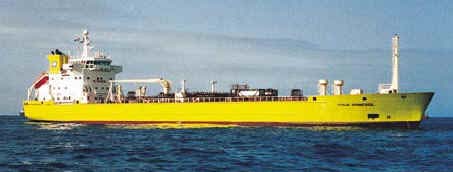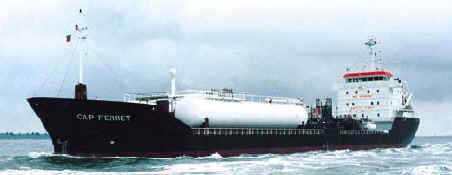
The
Shipbuilding Market in 1998
Europe
In 1997 many factors had contributed to an increase in the orderbooks of
European shipbuilders:
&127; the appreciation of the dollar by about 15% against the
European currencies, in a market dominated by transactions in dollars,
- the return to higher growth in Europe,
- a large number of oil and gas projects, generating many offshore market
orders,
- the renewal and expansion of the fleets of certain specialized ships
(chemical carriers, passenger ships, etc.)
In the early part of 1998, the stabilization of exchange parities, the
favorable economic situation and above all the increase in orderbooks for passenger ships
and cruiseships enabled the European yards to capitalize on their success and increase
their orderbook from 8 million gt at the end of 1997 (8.1 million gt in the third quarter
of 1997) to 9.4 million gt in the third quarter of 1998.
However, the second half of the year was marked by a series of
unfavorable economic parameters:
- the fall of the dollar by about 10% in the summer will make it more
difficult to take orders,
- the drop in chemical freight rates has already reduced orders for
chemical carriers,
- many offshore contracts will probably be postponed or abandoned because
of the fall in the price per barrel of oil,
- the slowdown in growth in the United States could temper the appetite of
the cruise companies,
- the Asian crisis began to produce its effects, pushing down the prices of
standard ships such as the containerships which constitute most of the Danish and German
production, &127; ships that until now were built in Europe, such as ro-ro ships and
ferries, are now being ordered by European shipowners from China and Korea.
The enthusiasm that the figures might arouse cannot mask the
difficulties of European shipbuilding.
The fall in the prices of standard ships and the elimination of national
plans have already dealt a fatal blow to the building of merchant ships of more than
35,000- 40,000 dwt. The few West-European yards that still build such ships (but for how
much longer?) can be counted on the fingers of one hand:
- Odense with its very large containerships of more than 6,000 teu for its
parent company AP Møller,
- Kvaerner Warnow Werft and MTW, again with very large containerships of
more than 5,000 teu, for P&O,
- Fincantieri with two Panamax bulk carriers for Bottiglieri,
- AESA - Sestao and Puerto Real - with shuttle tankers and FPSO
vessels,
- Harland & Wolff with one FPSO vessel and two drilling vessels.
The mass production of ships inevitably leads to economies of scale from
which the European yards do not benefit. For comparison, the orderbooks of the three
largest Korean yards, Hyundai HI, Daewoo and Samsung, are respectively 7.5, 5.2 and 4.6
million gt; the first is three times and the other two more than twice the orderbook of
all the German yards combined.
The major shipbuilding groups such as Kvaerner and AP Møller are
confronted with profit reductions, and will have to take difficult decisions to reduce
personnel or close sites.
The upcoming elimination of duty-free sales on ferries will reduce the
profitability of the operators and their investment capacity in an important market for
the European builders. However, this could also accelerate the orders for ships designed
to carry passengers only, such as high-speed ferries.
All the yards are worried about the time when they will have to take
orders without subsidies, starting in 2001. It is possible that they will not withstand
this further shock, while the Asian yards, after taking over the building of standard
ships, will also move into some European niche markets.
The Association of West European Shipbuilders is anxiously monitoring
the development of the market in Asia. It criticizes the Korean yards for having financed
their expansion and contributed to the drop in sale prices with debts that in the end will
not be repaid or will be considerably reduced. In other words, some of these yards should
have been declared bankrupt.
In addition, the devaluation of the won against the dollar by almost 50%
could deal a fatal blow to European shipbuilding.
Finally, and paradoxically, the German yard Kvaerner Warnow Werft is
accused of having exceeded its production capacity and is likely to have to pay a
fine.
It is clear that the European shipbuilders are feeling very bitter about
the political authorities, whose role is also to understand and defend the interests of
their citizens, the source of their legitimacy.
|
| France The situation of France this year is paradoxical.
On one hand, it should be congratulated for its good performance, since
its orderbook increased from 293,000 gt to 480,000 gt in 12 months. This growth is still
more significant when it is noted that the number of ships on order increased from 13 to
33.
On the other hand, the French government announced the planned closure
of the Ateliers et Chantiers du Havre, which encountered enormous difficulties in
fulfilling a contract to build three highly-sophisticated chemical carriers. It is the
second largest French shipyard, employing more than 800 persons, that will have to close.
France will have only the Chantiers de l'Atlantique (4,000 employees), the Constructions
Mécaniques de Normandie (500 employees), Alstom Leroux Naval (300 employees) and Piriou
(300 employees).
In comparison, Germany has about 25 shipbuilding yards, the Netherlands
27, Norway 20, Italy 18 and Spain 14.
Les Chantiers de l'Atlantique received orders for:
- two cruiseships, 702 berths, for Renaissance Cruises,
- one cruiseship, 750 berths, for Radisson,
- two cruiseships, 1,900 berths, for RCCL,
and delivered:
- the "Vision of The Seas", a 2,417-berth cruiseship, to
RCCL,
- two 702-berth cruiseships to Renaissance Cruises, the "R One"
and "R Two".
The other yard in the group, Alstom Leroux Naval, distinguished itself
by taking orders for:
- one high-speed ferry, 36 knots, 1,000 passengers and 210 cars, for the
Greek shipowner NEL Lines,
- one high-speed ferry, 43 knots, 1,100 passengers and 250 cars, for the
French shipowner SNCM,
- three tugs, 30 tonnes bollard pull, for the Tunisian shipowner
OPNT,
- six 3,500 bhp tugs and eight 4,500 bhp tugs for the French shipowner Les
Abeilles,
and delivered the 95-passenger cruiseship "Le Levant" to the
Compagnie des Iles du Ponant.
Nearly 80% of the production of French yards consists of cruiseships. In
this niche market the main competition is European. However, this is an uncomfortable
position, always vulnerable to a change in trends.
 |
Le Levant
3,000 gt, 95 passengers, built 1998 by Alsthom Leroux Naval,
owned by Compagnie des Iles du Ponant ©Guillaume Plisson |
|
| Germany With an orderbook of 2.35 million gt, Germany occupies
first place in Europe, in front of Italy, and confirms its fourth place in the world,
behind China.
Four types of ship dominate its orderbook:
- containerships (44%)
- cruiseships (23%)
- ro-ro ships (10%)
- cargo ships (8%)
Germany has a 14% market share for containerships,
but is threatened by direct competition from Korean (31%), Japanese (29%) and Taiwanese
(7%) yards. The managing director of the MTW yard, fully modernized and extremely
competitive, spoke out in September 1998 against "Asian dumping", emphasizing
that the sale prices did not allow the company to cover its purchases. His reaction is
understandable: if labor costs effectively represented about 30% of the sale price before
the crisis, what is left when the prices have dropped by a similar figure and as fast as
they have?
Cruiseships comprise a significant share of German
production. This sector is better protected in that the market is held almost exclusively
by European yards.
Italy
With 2.3 million gt, Italy was neck and neck with
Germany in 1998.
Three types of ship dominate Italian
shipbuilding:
- cruiseships (47%)
- ro-ro ships (24%)
- chemical carriers (10%)
In contrast to Germany, Italy works in sectors
that are better protected against Asian competition. Italian shipbuilders occupy first
place in the highly coveted club of cruiseship builders. They were able to benefit from
the dynamism of Italian shipowners, who placed orders with them for cruiseships, ro-ro
ships and chemical carriers. The freight rate levels have already forced the yards that
were specialized in the building of chemical carriers to redirect their efforts toward
other ships.
Nevertheless, the Italian shipowners also placed
many merchant ship orders abroad, particularly in Croatia, Korea, China and Denmark, ships
that could have been built a few years ago in Italian shipyards. It is one of the
preoccupations of Fincantieri, a multi-yard shipbuilder, to convert some of its yards,
optimized for the building of standard ships, for other more sophisticated ships.
In addition, the Italian state is examining the
possibility of privatizing the three state-owned yards, Fincantieri, INMA and
Apuania.
Spain
The Spanish yards occupy third place in Europe,
with 1.11 million gt. They are world leaders in the ro-pax carrier market with a 33% share
in the third quarter of 1998, in front of Italy, Germany and the Netherlands. However,
most shipbuilding production is accounted for by shuttle tankers (32%) and chemical
carriers (23%). The fall in the price per barrel of oil and in chemical freight rates has
already slowed the ordering rate for these two types of ship, which will probably lead to
some reconversion difficulties in 1999.
Finland
With cruiseships representing 80% of its market,
Finland saw its orderbook increase from 631,000 gt in the third quarter of 1997 to 825,000
gt in the third quarter of 1998.
Denmark
The Danish shipyards suffered from international
competition and their orderbook fell from 922,000 gt to 746,000 gt in 12 months. The main
Danish shipbuilder, Odense, which contributes more than 80% of the Danish orderbook with a
series of large containerships, was obliged to lay off part of its work force, while the
future of the other major Danish shipyard, Danyard, is very uncertain.
 |
Tour Pomerol
Chemical parcel tanker, 10,400 dwt, blt 1998 by YVC Ysselwerf BV,
operated by Tankafrica |
Netherlands
The excellent performance of the Dutch yards
should be highlighted, their orderbook increasing from 444,000 gt (in September 1997) to
709,000 gt (in September 1998).
The performance is even more remarkable in terms
of the number of ships; with approximately 300 units on order, the Netherlands takes a
place behind Japan (about 530) but between Korea (about 320) and China (about 200). Of
course the ships are smaller than in Asia, but the number is quite a good indicator of the
importance of Dutch shipbuilding, in particular for the equipment suppliers delivering as
many engines, auxiliaries, pumps, etc.
Cargo ships dominate Dutch production with 62%,
placing the country in second place in this sector behind China (22%) but ahead of Japan
(8%) and Korea.
 |
Cap Ferret
product/chemical tanker and LPG carrier 8,012 dwt, blt 1998 by
Niestern Sander BV, operated by Petromarine |
Norway
The Norwegian yards, mainly specialized in the
building of chemical carriers and offshore units, were affected by the contraction of
these markets this year. The weakness of the Norwegian krone as a consequence of the fall
in the price per barrel of oil could give Norway additional competitiveness in 1999
compared with other European yards.
Croatia
Early in 1998 Croatia was able to profit from the
uncertainty in the Asian markets. However, the pressure on the prices of standard ships
meant that it lost orders, notably for refined product carriers, so the orderbook shrank
from 939,000 gt to 853,000 gt.
Poland
Like the Croatian yards, the Polish shipyards may have
profited from the uncertainty in Asia to take orders early in the year (LPG and chemical
carriers). But the Asian pressure was strong, and the fall in prices of standard ships
prevented Poland increasing its orderbook in 1998, with a drop from 1,267,000 gt to
1,111,000 gt. |
Shipping and Shipbuilding Markets 1999
I N D E X
|